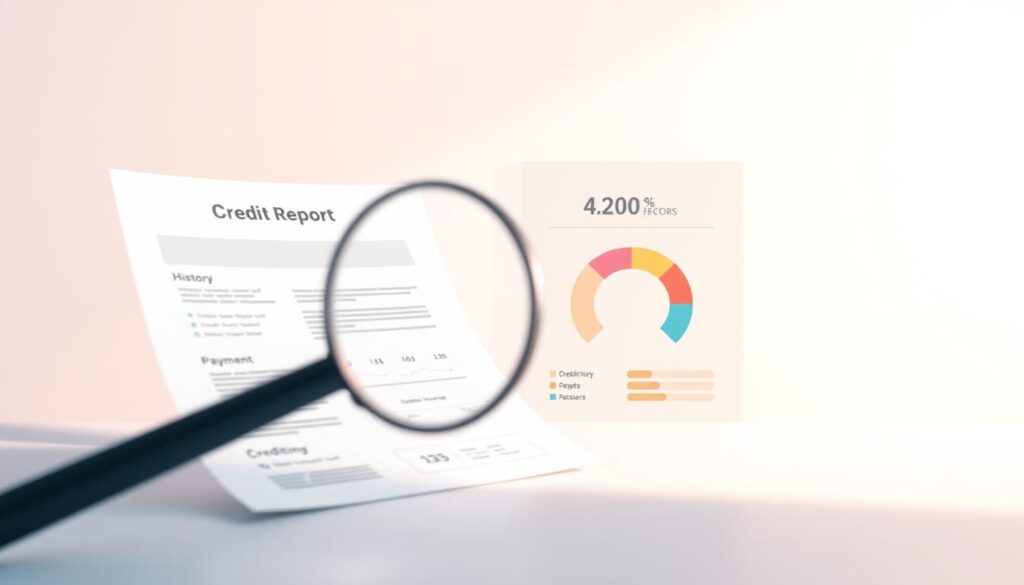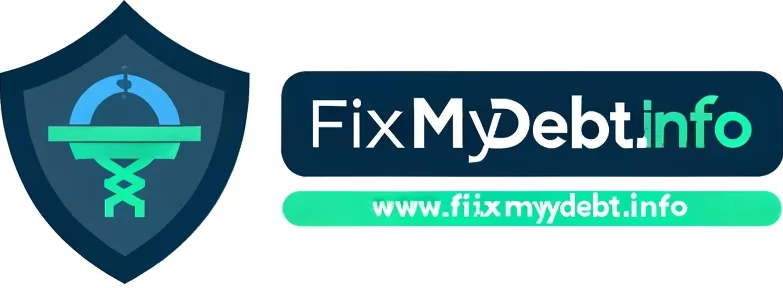Did you know that the average credit score in the U.S. is around 718, but a score of 760 or higher can unlock the best loan rates1? Your credit score is a numerical indicator that lenders use to assess your financial reliability. It ranges from 300 to 850, with higher numbers signaling better creditworthiness1.
Improving your credit score quickly can lead to more favorable loan terms and lower interest rates. This is crucial because your score impacts the total cost of borrowing, potentially saving you thousands of dollars over time1.
Understanding what affects your score is the first step. Payment history and credit utilization are the most significant factors, accounting for 35% and 30% of your score, respectively1. By focusing on these areas, you can make meaningful improvements. Let’s dive into actionable strategies to boost your score fast.
Overview of Credit Scores and Their Impact
Your financial health often hinges on a three-digit number that lenders rely on heavily. This number, often referred to as a credit score, is a key factor in determining your eligibility for loans and other financial products. It’s a reflection of your financial behavior and trustworthiness in the eyes of lenders2.
At its core, a credit score is a numerical representation of your credit history. It’s calculated based on factors like payment behavior, amounts owed, and the length of your credit accounts3. Lenders use this score to assess the risk of lending to you. A higher score often translates to better loan terms and lower interest rates4.
Definition and Purpose
A credit score is a tool that helps lenders evaluate your financial reliability. It ranges from 300 to 850, with higher numbers indicating lower risk2. Scores above 700 are generally viewed positively, while those above 800 are considered excellent3.
The purpose of this score is to provide a quick snapshot of your financial habits. It helps lenders decide whether to approve your application and what terms to offer. Timely payments and low credit utilization are critical for maintaining a strong score4.
Why Credit Scores Matter for Loans
When you apply for a loan, your credit score plays a pivotal role. Lenders use it to determine the interest rate and terms you qualify for. A higher score can save you thousands of dollars over the life of a loan2.
For example, borrowers with scores above 750 often qualify for 0% financing on cars and credit cards with introductory offers4. On the other hand, a lower score can lead to higher interest rates or even loan denial.
“Your credit score is your financial passport—it opens doors to better opportunities,”
says a financial expert.
In summary, understanding your credit score and its impact can help you make informed financial decisions. By focusing on factors like payment history and credit utilization, you can improve your score and unlock better loan options3.
Understanding the Basics of Credit Scores
Your financial future is shaped by a number that lenders use to evaluate your trustworthiness. This number, often referred to as a credit score, is a key factor in determining your eligibility for loans and other financial products. It’s a reflection of your financial behavior and trustworthiness in the eyes of lenders5.

What is a Credit Score?
A credit score is a numerical representation of your financial habits. It ranges from 300 to 850, with higher numbers indicating lower risk5. Scores above 700 are generally viewed positively, while those above 800 are considered excellent6.
The purpose of this score is to provide a quick snapshot of your financial reliability. It helps lenders decide whether to approve your application and what terms to offer. Timely payments and low credit utilization are critical for maintaining a strong score.
How Credit Scores are Calculated
Credit bureaus compile data from various sources to calculate your score. This includes information from your credit report, such as payment history, amounts owed, and the length of your credit accounts5.
Payment history accounts for 35% of your score, making it the most significant factor. Credit utilization, or the amount of debt you owe, contributes 30%. The length of your credit history and the types of credit used also play important roles6.
For example, using a credit card responsibly can positively impact your score. However, maxing out your card or missing payments can have the opposite effect. Regularly reviewing your credit report can help you identify errors and ensure accuracy5.
The Role of Credit Scores in Better Loan Qualification
Your ability to secure favorable loan terms often depends on a three-digit number that lenders analyze closely. This number reflects your financial habits and helps lenders assess the risk of lending to you. A higher number can unlock lower interest rates and better loan conditions7.
Influence on Interest Rates and Terms
Lenders use your financial history to determine the terms of your loan. A strong account history positions you as a lower-risk borrower, which can lead to significant savings. For example, a borrower with a score of 760-850 may secure an interest rate of 3.307% on a $200,000 mortgage, while someone with a score of 620-639 could face a rate of 4.869%8.
The difference in monthly payments between these two ranges is $184. Over the life of a 30-year mortgage, this could cost an additional $66,3438. Maintaining a good account balance and timely payments are crucial for securing favorable terms.
Here’s a breakdown of how different scores impact mortgage rates:
| Score Range | Interest Rate | Monthly Payment | Total Interest Cost |
|---|---|---|---|
| 620-639 | 4.869% | $1,061 | $381,960 |
| 700-719 | 4.123% | $969 | $348,840 |
| 760-850 | 3.307% | $877 | $315,720 |
Lenders also consider the length of your account history and the types of accounts you hold. A diverse portfolio of accounts, such as credit cards and loans, can positively influence their decision7.
By understanding how lenders evaluate your financial history, you can take steps to improve your position. Focus on maintaining a low account balance and making timely payments to secure the best possible terms8.
Key Components of Your Credit Score
Understanding the key elements that shape your financial profile can make a big difference in your loan approval process. These components are used by lenders to evaluate your reliability and determine the terms of your loan. Let’s break down the most important factors.
Payment History
Your payment history is the most significant factor, accounting for 35% of your financial profile9. Paying your bills on time consistently shows lenders that you’re reliable. Missing even one payment can have a negative impact, especially if it’s 30 days late or more10.
To improve credit in this area, set up reminders or automatic payments. This ensures you never miss a due date. Over time, consistent on-time payments will strengthen your profile.

Credit Utilization and Account Balances
Credit utilization, or the amount of debt you owe compared to your limits, makes up 30% of your profile9. Keeping your balances low—ideally below 10%—can positively influence your financial standing10.
For example, if you have a $1,000 limit, try to keep your balance under $100. High utilization rates, especially above 30%, can harm your profile. Regularly paying down balances is a simple way to improve credit.
Length of Credit History & Credit Mix
The length of your credit history contributes 15% to your profile, while your credit mix accounts for 10%9. A longer history shows lenders you have experience managing accounts. A diverse mix, such as having both credit cards and loans, can also be beneficial.
For instance, maintaining older accounts in good standing can help. Closing them might shorten your history and lower your profile. Similarly, having a variety of account types demonstrates your ability to handle different financial responsibilities.
By focusing on these components—payment history, credit utilization, and credit mix—you can take meaningful steps to improve credit and secure better loan terms.
Steps to Improve Your Credit Score Fast
Boosting your financial profile quickly requires focused actions and consistent habits. By addressing key areas like payment behavior and debt management, you can see positive changes in as little as 30 to 45 days11. Let’s explore actionable strategies to help you achieve this.
Making Timely Payments
Your payment history is the most significant factor in your financial profile, accounting for 35% of the calculation12. Missing even one payment can have a lasting negative impact, especially if it’s 30 days late or more11.
To stay on track, set up reminders or automatic payments. This ensures you never miss a due date. Over time, consistent on-time payments will strengthen your profile and improve your score credit.
Reducing Outstanding Balances
Credit utilization, or the amount of debt you owe compared to your limits, makes up 30% of your profile12. Keeping your balances low—ideally below 10%—can positively influence your financial standing11.
For example, if you have a $1,000 limit, try to keep your balance under $100. High utilization rates, especially above 30%, can harm your profile. Regularly paying down balances is a simple way to improve your financial health.
Here’s a comparison of strategies to reduce balances effectively:
| Strategy | Impact | Timeframe |
|---|---|---|
| Pay more than the minimum | Reduces principal faster | Short-term |
| Budgeting | Frees up money for payments | Ongoing |
| Debt consolidation | Lowers interest rates | Medium-term |
Monitoring your credit score range regularly is also crucial. This helps you track progress and identify areas for improvement. By managing your money responsibly and focusing on these steps, you can achieve a stronger financial profile and unlock better opportunities13.
Practical Strategies for Quick Credit Improvement
Taking control of your financial profile starts with understanding how certain actions can impact it. Two key areas to focus on are minimizing hard inquiries and avoiding unnecessary new debt. Both can significantly influence your financial standing and help you achieve your goals faster.
Minimizing Hard Inquiries
Hard inquiries occur when lenders check your financial profile during a loan or credit card application. Each inquiry can temporarily lower your profile, and multiple inquiries in a short period may raise red flags for lenders14.
To minimize their impact, group similar applications within a 14 to 45-day window. This allows scoring models to treat them as a single inquiry, reducing the effect on your history14. For example, when shopping for a mortgage, submit all applications within this timeframe.
Avoiding Unnecessary New Debt
Taking on new debt can increase your utilization rate, which accounts for 30% of your financial profile15. High utilization can negatively impact your standing, especially if it exceeds 30% of your available limit.
Instead of opening new accounts, focus on managing existing ones. Pay down balances and avoid maxing out cards. This disciplined approach helps maintain a healthy profile and improves your chances of qualifying for better rates14.
Remember, even a few missed payments can harm your payment history, which is the most significant factor in your profile15. Stay organized and prioritize timely payments to protect your financial health.
Building and Maintaining a Strong Credit History
Building a strong financial foundation starts with understanding how to manage your accounts effectively. A diverse portfolio and consistent habits are key to long-term success. By focusing on these areas, you can improve your financial standing and unlock better opportunities16.

Establishing a Diverse Portfolio
A mix of account types, such as revolving and installment accounts, can positively impact your financial profile. For example, having both a credit card and a personal loan shows lenders you can handle different responsibilities17.
Here’s a quick comparison of account types and their benefits:
| Account Type | Benefits |
|---|---|
| Revolving (e.g., credit cards) | Flexible spending, builds payment history |
| Installment (e.g., loans) | Fixed payments, demonstrates reliability |
Strategies for Long-Term Financial Health
Regularly checking your report using free credit monitoring tools can help you spot errors and unauthorized activity16. This practice ensures accuracy and protects your financial standing.
Maintaining low balances and making timely payments are essential. Experts recommend keeping your utilization rate below 30% to avoid negative impacts17.
For more detailed strategies, check out this guide on how to build credit.
By following these steps and using credit responsibly, you can achieve a robust financial profile over time. Consistency and awareness are your best tools for success.
Managing Credit Inquiries and Avoiding Negative Impacts
Not all inquiries are created equal—some can impact your financial health more than others. Understanding the difference between soft and hard inquiries is crucial for maintaining a strong profile and protecting your loan eligibility.
Soft vs. Hard Inquiries
Soft inquiries occur when you check your own profile or when lenders pre-approve you for offers. These do not affect your financial standing and are not visible to lenders18. On the other hand, hard inquiries happen when you apply for new credit, such as a loan or credit card. These can temporarily lower your profile by a few points19.
Hard inquiries remain on your report for up to two years but only directly impact your scoring model for one year19. Multiple hard inquiries in a short period can raise red flags for lenders, as they may view you as a higher risk18.
Techniques to Limit New Inquiries
To minimize the impact of hard inquiries, group similar applications within a 14 to 45-day window. This allows scoring models to treat them as a single inquiry19. For example, when shopping for a mortgage or auto loan, submit all applications within this timeframe.
Another strategy is to avoid unnecessary new debt. Taking on too much debt can increase your utilization rate, which negatively affects your profile18. Focus on managing existing accounts responsibly instead of opening new ones.
Protecting Your Score Range
Understanding the difference between soft and hard inquiries can help you protect your score range. Regularly monitor your profile for unauthorized inquiries and dispute them promptly. Disputes are usually resolved within 30 days but may take up to 45 days in some cases19.
For more tips on managing your financial health, check out this guide on understanding debt types and causes. By staying informed and proactive, you can maintain a strong profile and unlock better opportunities.
Understanding Different Credit Scoring Models
Understanding how lenders evaluate your financial behavior can help you make smarter decisions. Two of the most widely used scoring models are FICO® and VantageScore. Both use a range of 300 to 850, but they assess data differently. Knowing these differences can empower you to take control of your financial profile.

FICO® Score Explained
The FICO® score is the most widely used scoring model, with approximately 90% of lenders relying on it20. It evaluates five key factors: payment history (35%), credit utilization (30%), length of credit history (15%), credit mix (10%), and new credit inquiries (10%)21. This model is designed to predict how likely a person is to repay debt.
FICO® has over 50 versions of its scoring model, tailored for different industries20. For example, the FICO 9 model introduced in 2014 reduced the weight of unpaid medical bills and included rental history20. These updates reflect the company’s commitment to evolving with consumer needs.
Overview of VantageScore
VantageScore, introduced in 2006, is another popular scoring model. It uses a similar range of 300 to 850 but includes a letter grade (A through F) for better clarity20. This model focuses on six factors: payment history (40%), age and type of credit (21%), credit utilization (20%), total balances (11%), recent behavior (5%), and available credit (3%)21.
One key difference is that VantageScore ignores collections under $250 and accounts affected by natural disasters20. This makes it more inclusive for people with unique financial situations.
Here’s a comparison of the two models:
| Feature | FICO® | VantageScore |
|---|---|---|
| Range | 300-850 | 300-850 |
| Payment History Weight | 35% | 40% |
| Credit Utilization Weight | 30% | 20% |
| Unique Feature | Industry-specific versions | Letter grade system |
Understanding these models can help you focus on the right areas to improve your financial profile. Whether it’s making timely payments or managing credit utilization, knowing how each company evaluates your behavior is key to success.
Effective Ways to Use Your Credit Report to Boost Your Credit Score
Your credit report is a powerful tool that can help you improve your financial standing. By understanding its contents and taking proactive steps, you can correct errors and ensure your profile reflects accurate information. This process not only enhances your financial health but also opens doors to better opportunities22.

Identifying Errors and Inaccuracies
Start by thoroughly reviewing your report for any errors or outdated information. Common mistakes include incorrect account balances, misreported payment history, or accounts that don’t belong to you. Around 20% of consumers have errors on their reports that could affect their financial standing22.
Focus on key factors like payment history and credit utilization, as these account for a significant portion of your profile23. If you spot discrepancies, gather supporting documents to prepare for the dispute process. Accurate information is crucial for maintaining a strong financial profile.
Disputing and Updating Information
Once you’ve identified errors, the next step is to dispute them with the credit bureaus. This involves submitting a formal request along with evidence to support your claim. Most disputes are resolved within 30 days, but some may take up to 45 days22.
Updating your report with accurate information can have a positive impact. For example, correcting a late payment status or removing an account that’s not yours can improve your profile. Regularly monitoring your report ensures you catch errors early and maintain a healthy financial standing24.
Here’s a quick guide to disputing inaccuracies:
- Gather supporting documents (e.g., bank statements, payment receipts).
- Submit a dispute letter to the credit bureau.
- Follow up to ensure the issue is resolved.
By taking these steps, you can use your credit report as a tool for improvement and protect your financial future.
Real-World Examples of Credit Score Improvements
Seeing real-life examples of financial improvement can inspire and guide your own journey. By examining how others successfully managed their bureau reports and credit limits, you can learn actionable strategies to improve your financial profile.
Case Studies and Success Stories
Let’s explore two individuals who transformed their financial standing within a year. Jeff started with a FICO score of 680, struggling with high utilization and delinquencies. By reducing his balances and disputing errors on his bureau report, he boosted his score to 72025.
Michelle, on the other hand, maintained a strong profile but faced challenges after maxing out a card. She quickly paid down the balance and avoided new inquiries, restoring her score to 78025. These stories highlight the importance of proactive management.
Lessons Learned from Financial Improvements
From these examples, key lessons emerge. First, regularly reviewing your bureau report helps identify and correct errors. Second, keeping your credit limit utilization below 30% is crucial for maintaining a healthy profile26.
Here’s a summary of actionable steps:
- Monitor your report for inaccuracies and dispute errors promptly.
- Pay down balances to keep utilization low.
- Avoid unnecessary new debt to minimize inquiries.
By following these strategies, you can achieve significant improvements in your financial profile. As one expert noted,
“Small, consistent actions lead to lasting financial success.”
| Strategy | Impact | Timeframe |
|---|---|---|
| Dispute Errors | Corrects inaccuracies | 30-45 days |
| Reduce Utilization | Improves profile | 1-2 months |
| Avoid New Debt | Minimizes inquiries | Ongoing |
These real-world examples demonstrate that with focus and discipline, you can achieve meaningful financial improvements. Start today and take control of your future.
Conclusion
Achieving financial stability starts with understanding how to manage your accounts effectively. By focusing on key strategies like making timely payments and reducing outstanding balances, you can see significant improvements in your financial profile27.
Maintaining a diverse portfolio and regularly checking your report for errors are essential steps. For example, keeping your utilization rate below 30% can positively influence your standing28. These actions not only boost your profile but also open doors to better opportunities.
The long-term benefits of a higher financial standing are clear. You can secure lower interest rates and more favorable loan terms, saving you thousands over time. Start today by reviewing your report and disputing any inaccuracies. This is a proven way to take control of your financial future.
By following these strategies, you can achieve lasting financial success. Take the first step now and see the difference it makes.
FAQ
What is a credit score, and why is it important?
How can I quickly improve my credit score?
What factors influence my credit score the most?
How do credit inquiries affect my score?
What’s the difference between FICO® and VantageScore?
How can I build a strong credit history over time?
Can errors on my credit report hurt my score?
Source Links
- How to Improve Your Credit Score in 7 Steps – https://www.schwab.com/learn/story/how-to-improve-credit-score
- What Is a Credit Score? Definition, Factors, and Ways to Raise It – https://www.investopedia.com/terms/c/credit_score.asp
- What Is a Credit Score & Why Is It Important? | Equifax – https://www.equifax.com/personal/education/credit/score/articles/-/learn/what-is-a-credit-score/
- Credit Score Ranges: What Are They and Why Do They Matter? – NerdWallet – https://www.nerdwallet.com/article/finance/credit-score-ranges-and-how-to-improve
- Understanding Your Credit – https://consumer.ftc.gov/articles/understanding-your-credit
- Credit Score Basics: Everything You Need to Know – https://www.experian.com/blogs/ask-experian/credit-education/score-basics/understanding-credit-scores/
- What Is a Good Credit Score? – https://www.experian.com/blogs/ask-experian/credit-education/score-basics/what-is-a-good-credit-score/
- How Your Credit Score Impacts Your Financial Future – https://www.finra.org/investors/personal-finance/how-your-credit-score-impacts-your-financial-future
- How are FICO Scores Calculated? | myFICO – https://www.myfico.com/credit-education/whats-in-your-credit-score
- What Affects Your Credit Scores? – https://www.experian.com/blogs/ask-experian/credit-education/score-basics/what-affects-your-credit-scores/
- How to Raise Your Credit Scores Fast | Equifax – https://www.equifax.com/personal/education/credit/score/articles/-/learn/raise-credit-scores-fast/
- 5 Ways to Improve Your Credit Score & Credit Boosting Tips – https://bettermoneyhabits.bankofamerica.com/en/credit/how-to-improve-your-credit-score
- How to Improve Your FICO Score | myFICO – https://www.myfico.com/credit-education/improve-your-credit-score
- How To Improve Your Credit Score – 8 Simple Rules And Strategies – https://www.forbes.com/sites/truetamplin/2024/11/28/how-to-improve-your-credit-score–8-simple-rules-and-strategies/
- Tricks to improve your credit score — and keep it high – https://www.npr.org/2020/11/09/933053299/tricks-to-improve-your-credit-score
- How to Build a Good Credit Score and Credit History – https://www.td.com/us/en/personal-banking/finance/building-good-credit-score
- How to build and maintain a solid credit history and score – https://www.usbank.com/financialiq/manage-your-household/establish-credit/how-to-build-and-maintain-a-solid-credit-history-and-score.html
- How Credit Inquiries Impact Your Credit Score – https://credevolv.com/how-credit-inquiries-impact-your-credit-score/
- What Is a Hard Inquiry and How Does It Affect Credit? – https://www.experian.com/blogs/ask-experian/what-is-a-hard-inquiry/
- Credit Scoring Models: FICO, VantageScore & More – https://www.debt.org/credit/report/scoring-models/
- Understanding Credit Scoring Models: Types and Examples – https://www.highradius.com/resources/Blog/credit-scoring-models-types-and-examples/
- Tips on How to Improve Credit Score | Equifax – https://www.equifax.com/personal/education/credit/score/articles/-/learn/how-to-improve-credit-score/
- How to Improve Your Credit Score: Tips & Tricks – https://www.debt.org/credit/improving-your-score/
- 4 tips to boost your credit score fast – https://www.cnbc.com/select/how-to-boost-your-credit-score-fast/
- Credit Scoring Example – https://www.greenpath.com/blog/credit-score-example/
- Understanding debt & credit scores – https://www.ama-assn.org/medical-residents/medical-residency-personal-finance/understanding-debt-credit-scores
- Does Closing a Credit Card Hurt Your Credit? – NerdWallet – https://www.nerdwallet.com/article/finance/does-closing-a-credit-card-hurt-credit-score
- Does Closing a Credit Card Hurt Your Credit? | Capital One – https://www.capitalone.com/learn-grow/money-management/does-closing-a-credit-card-hurt-credit-score/

